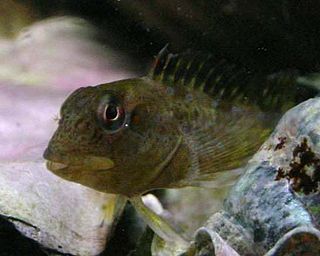
Combtooth blennies are blenniiformids; percomorph marine fish of the family Blenniidae, part of the order Blenniiformes. They are the largest family of blennies with around 401 known species in 58 genera. Combtooth blennies are found in tropical and subtropical waters in the Atlantic, Pacific and Indian Oceans; some species are also found in brackish and even freshwater environments.

Malacoctenus is a genus of labrisomid blennies native to the eastern Pacific Ocean and the Atlantic Ocean.

Mugil is a genus of mullet in the family Mugilidae found worldwide in tropical and temperate coastal marine waters, but also entering estuaries and rivers.

Clinus is a genus of clinids found in the southeastern Atlantic and western Indian Ocean.

Entomacrodus is a genus of combtooth blennies.

Salarias is a genus of combtooth blennies found in the Indian and Pacific oceans.

Ecsenius is a large genus of fish in the family Blenniidae. Several species, including Ecsenius midas, the Midas blenny, and Ecsenius bicolor, the bicolor blenny, are commonly sold at aquarium stores as pets.

Scartella cristata, also known by the vernacular names molly miller or molly miller blenny, is a species of marine ray-finned fish belonging to the family Blenniidae, the combtooth blennies. This species is found in the Atlantic, Mediterranean, and northwest Pacific Oceans. Its colour is a mottled tan, white, and black covering the body and fins. The head of this fish is covered with short hair-like appendages and has two very large eyes. This species reaches 12 cm (4.7 in) in total length.

Cirripectes is a large genus of combtooth blennies found throughout the Pacific and Indian oceans. Cirripectes biconvexus, an otolith based fossil species from the Burdigalian (Miocene) of southwestern India is probably the earliest record of this genus.

Lipophrys is a small genus of combtooth blennies found in Atlantic ocean and the Mediterranean Sea. It is one of 57 genera in the family Blenniidae. The generic name is made up of the Greek words lipo meaning "want" or "absence" and phrys meaning "eyebrow" referring to the lack of any cirri over the eyes in the type species L. pholis.

Omobranchus is a large genus of combtooth blennies found in the Pacific, Atlantic, and Indian oceans.

The Portuguese blenny, also known as the red blenny, is a species of combtooth blenny found in the eastern Atlantic ocean off western Europe and Macaronesia.

Petroscirtes is a genus of combtooth blennies found in the western Pacific, and Indian oceans. Some species of this genus have venom that interacts with opioid receptors. Adults usually inhabit coastal reefs and estuaries to depths of about 10 meters, but they can also be found up to 15 meters in depth in sandy and weedy areas among clumps of Sargassum or other seaweeds in coastal and lagoon reefs. They can be found in nests inside small-necked bottles and abandoned worm tubes or shells.

Scartella is a genus of combtooth blennies found in the Atlantic and Indian oceans.

Ophidion is a genus of cusk-eels.

Iniistius is a genus of wrasses native to the Indian and Pacific Oceans.

The Tstsikamma Marine Protected Area is a marine protected area on the south coast of South Africa, in both the Western Cape and Eastern Cape. It is on the coast of the Tsitsikamma National Park, and is one of the oldest MPAs in the country. The MPA provides protection for marine habitat and wildlife, including birds and threatened and endangered fish species.

Salarinae is one of two subfamilies in the combtooth blenny family Blenniidae, it is the largest of the two subfamilies in the Blennidae with 43 genera. The species in this subfamily are mainly marine, with a few species which are found in freshwater or brackish water, and a few species are known to spend much time out of the water.

Blenniinae is one of two subfamilies in the combtooth blenny family Blenniidae, it is the smallest of the two subfamilies in the Blennidae with 16 genera and 95 species.

















